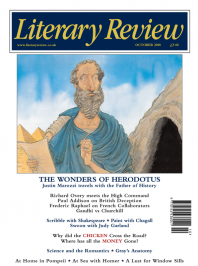David Ellis
It’s Behind You!
The Casebook of Victor Frankenstein
By Peter Ackroyd
Chatto & Windus 304pp £16.99
Byron thought that Frankenstein was a wonderful work for a girl of eighteen. Mary Shelley’s subsequent writings were never so impressive and suggested that the success of her first novel had more to do with conception than execution: a strong initial idea rather than a display of exceptional literary talent. She was lucky in that the idea or topic at the heart of Frankenstein – the unintended consequences of scientific experiment – became more rather than less relevant as the years passed. Even in her own day there were adaptations for the theatre, and later in the nineteenth century these proliferated. Film added new dimensions to the story, and in print fresh reworkings continued to appear. The novel is now so much better known than anything Byron ever wrote that his reference to a girl of eighteen begins to sound patronising.
Peter Ackroyd is treading where many others have trod before, but the contribution he makes to the Frankenstein legend is characteristically intriguing. In his version, Victor tells not just part but the whole of his own story and includes within it Mary Shelley, her husband, William Godwin, Byron, Polidori and

Sign Up to our newsletter
Receive free articles, highlights from the archive, news, details of prizes, and much more.@Lit_Review
Follow Literary Review on Twitter
Twitter Feed
Russia’s recent efforts to destabilise the Baltic states have increased enthusiasm for the EU in these places. With Euroscepticism growing in countries like France and Germany, @owenmatth wonders whether Europe’s salvation will come from its periphery.
Owen Matthews - Sea of Troubles
Owen Matthews: Sea of Troubles - Baltic: The Future of Europe by Oliver Moody
literaryreview.co.uk
Many laptop workers will find Vincenzo Latronico’s PERFECTION sends shivers of uncomfortable recognition down their spine. I wrote about why for @Lit_Review
https://literaryreview.co.uk/hashtag-living
An insightful review by @DanielB89913888 of In Covid’s Wake (Macedo & Lee, @PrincetonUPress).
Paraphrasing: left-leaning authors critique the Covid response using right-wing arguments. A fascinating read.
via @Lit_Review